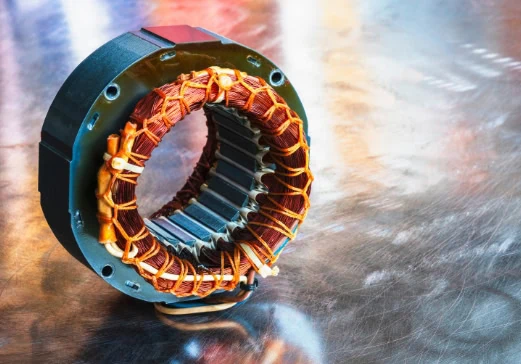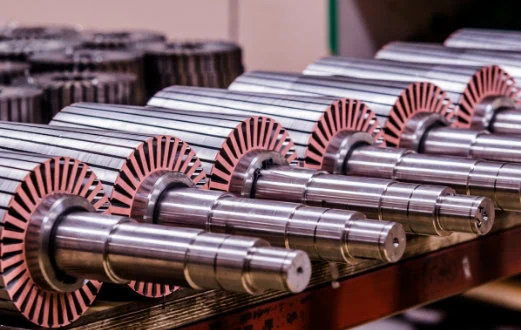Stators and rotors are essential parts of electric motors. Beyond the main difference-that stators are stationary and rotors rotate-there are other key distinctions between these key components.
Electric motors convert electrical energy into mechanical energy. The two main components of an electric motor are the stator, which does not move, and the rotor, which does. Magnets are attached to the rotor, while armatures are attached to the stator. Together, these components form a magnetic circuit.
Stators and rotors are typically made of thin metal sheets precisely cut and assembled into lamination stacks, their materials and designs determined by the motor’s intended performance. Learn more about the differences between stators vs. rotors, including their respective pros and cons.
What Is a Stator?
In electric motors, stators are the stationary components through which energy flows from or to the rotor. When energized with alternating current (AC), the stator produces a magnetic field that interacts with the rotor to create rotational motion. The three major parts of a stator are the stator frame, core, and winding.
In electric generators, the stator converts the rotating electromagnetic field into electric current. In fluid-driven devices, the stator guides fluid flow to and from the rotor. Motor stators are generally made from iron, steel, or a printed circuit board (PCB). PCB stators are typically used for low-power applications, as they can be smaller, lighter, and less noisy.
What Is a Rotor?
A rotor is the main moving part of an electric motor that spins and interacts with the stator’s magnetic field to convert electrical energy into mechanical motion. Mounted on the shaft of the motor and inside the stator, rotors can be made with wound wire or a series of permanent magnets. The rotor’s rotation is a result of the interaction between the magnetic field and the wound wire, which produces torque. The three main parts of a rotor are the rotor core, shaft, and winding.
Stator vs. Rotor: The Role of Each Component in Electric Motors
Stators
- Require maximization of their electromagnetic capabilities.
- Feature a complex winding arrangement through slots on the inside of the stator core.
- Are constructed with higher induction, higher permeability, and lower losses.
- Must have strong mechanical responses.
Thomson Lamination Company builds to spec to meet our customers’ highest-precision needs.
Rotors
- Rotate as a result of the interaction with the stator’s magnetic field, producing torque around the rotor.
- Have less flux, so their magnetic properties (e.g., permeability losses) are less strict than those of stators.
- Must have their mechanical properties optimized to achieve the desired motor responses.
Pros & Cons of Stators Within Electric Motors
Pros of Stators
Stators are a top choice for high-efficiency electric motors since advanced stator technology can reach efficiency levels of up to 95%. Lamination stacks and better insulating materials have improved stators' efficiency and performance. High-efficiency stators lead to extended battery life, energy savings, reduced operating costs, and a lower carbon footprint.
Cons of Stators
The major con of stators is that broken winding insulation typically causes stator faults. Stator winding insulation must endure high thermal stress, which has a significant effect on the quality and longevity of the insulation. Another drawback is electrical stress of the transient voltage. The increased use of soft start inverters means that square wave voltage pulses are controlled at the inverter's output.
Pros & Cons Of Rotors Within Electric Motors
Pros of Rotors
Rotors provide efficient power transmission with precise control over speed, torque, and other performance parameters. This allows for optimal operation, as the rotor ensures the machine uses the electrical energy as efficiently as possible. The durable and reliable design of most rotors enables long-term performance and minimizes downtime.
Cons of Rotors
The most common drawback of rotor design is the unevenness of the air gap between the stator and the rotor. Common causes of this problem include overloading and the use of inferior-quality materials. Another problem is broken rotor bars, which can increase the resistance of the bar or break the entire bar circuit. Rotor bar failures can cause engine starting deterioration and parasitic moments.
Electric Motor Laminations by Thomson Lamination Company
Both stators and rotors are made of high-precision, thin metal sheets called laminations. With a better understanding of stator vs. rotor components in electric motors, you can choose a lamination manufacturing partner for your unique project.
As a premier manufacturer of stamped electric motor components, Thomson Lamination Company can produce rotor and stator laminations to meet your application requirements. Producing standard and custom motor laminations, we work with high-conductivity metals and meet tight tolerances. We can also accommodate prototype to high-volume production runs.
Request a quote to learn how our electric motor lamination capabilities can assist with your project.

